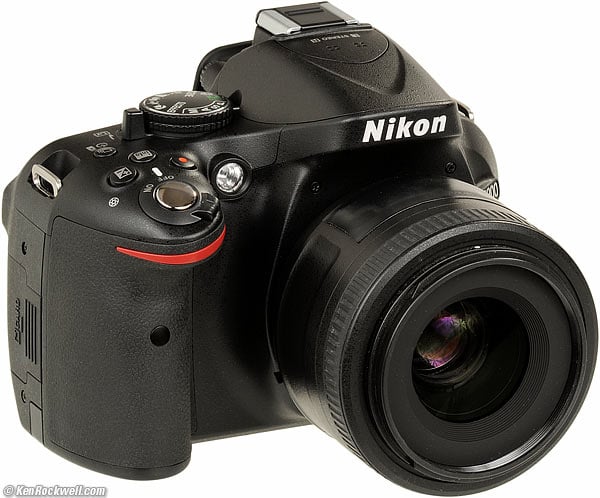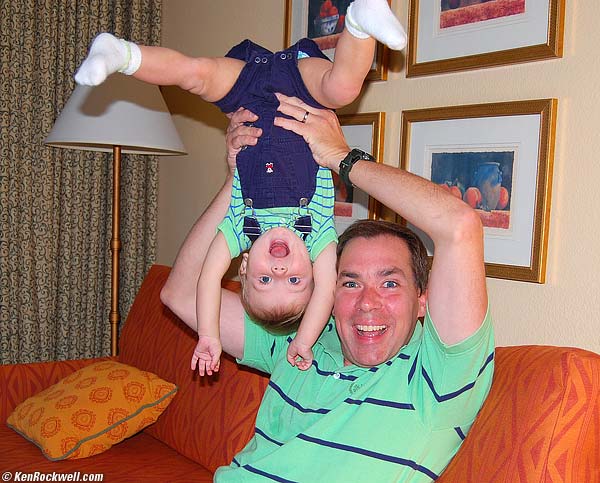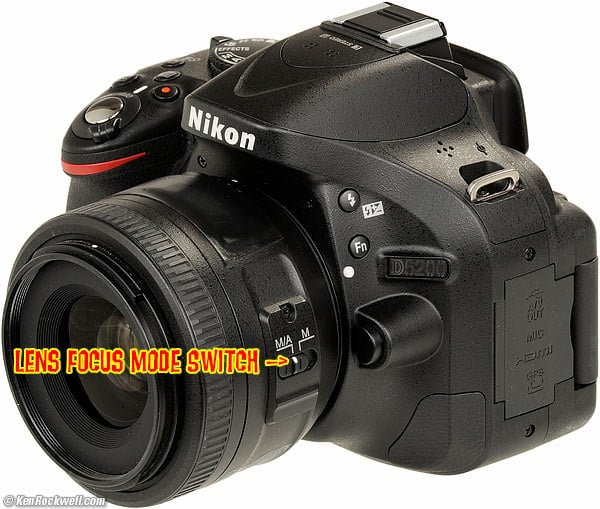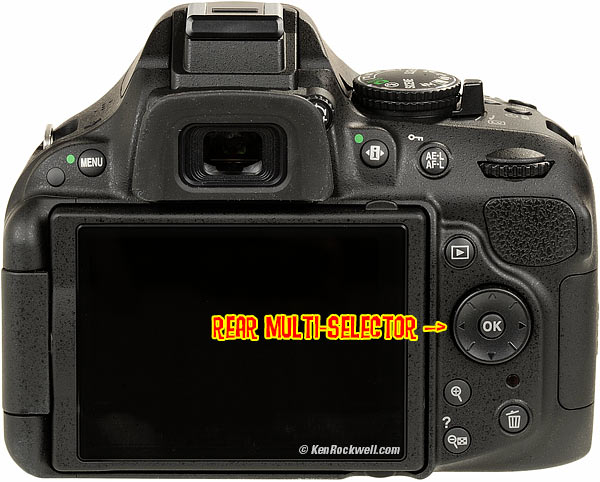Home Donate New Search Gallery Reviews How-To Books Links Workshops About Contact
Nikon
D5200 AF Settings
© 2013 KenRockwell.com. All rights reserved.

Nikon D5200 and 35mm f/1.8 DX (body weighs 19.6 oz./555 g with battery and card, about $800, or $900 with 18-55mm lens). enlarge. My biggest source of support is when you use any of these links, especially this link directly to it at Adorama or directly to it at Amazon, when you get anything, regardless of the country in which you live. Thank you! Ken.
February 2013 Nikon D5200 Review Nikon Reviews Nikon Lens Reviews
Help me help you top
I support my growing family through this website, as crazy as it might seem.
The biggest help is when you use any of these links when you get anything, regardless of the country in which you live. It costs you nothing, and is this site's, and thus my family's, biggest source of support. These places have the best prices and service, which is why I've used them since before this website existed. I recommend them all personally.
If you find this page as helpful as a book you might have had to buy or a workshop you may have had to take, feel free to help me continue helping everyone.
If you've gotten your gear through one of my links or helped otherwise, you're family. It's great people like you who allow me to keep adding to this site full-time. Thanks!
If you haven't helped yet, please do, and consider helping me with a gift of $5.00.
As this page is copyrighted and formally registered, it is unlawful to make copies, especially in the form of printouts for personal use. If you wish to make a printout for personal use, you are granted one-time permission only if you PayPal me $5.00 per printout or part thereof. Thank you!
Thanks for reading!
Mr. & Mrs. Ken Rockwell, Ryan and Katie.
This is how you set the autofocus (AF) system of the Nikon D5200. See my Guide to Nikon AF Settings for other cameras.
Many of these settings are locked-out when the D5200 is in the green AUTO mode, set on the big top dial. I shoot in the P mode, which allows all these settings. For this page, use the P, S, A or M modes and you'll have access to all these settings. If you're trying to do something below and it won't work, it's because you have the top dial set to AUTO.
The D5200 only autofocuses with the latest AF-S (and older professional AF-I) lenses. Most traditional (screw-type) AF lenses from 1986 through today will not autofocus on the D5200. If your lens says "AF-S," you're fine; most lenses sold today for the D5200 are AF-S.
Most non-Nikon lenses from Tamron, Tokina, Quantaray, Sigma and anyone other than Nikon may not autofocus at all on the D5200.
Autofocus systems are fast, but not usually instantaneous. You have to hold the shutter down halfway as you compose the first shot so the AF system can focus and lock, and then the camera fires instantaneously when you press the shutter the rest of the way. See Preventing Shutter Delay for more.
The great news is that the D5200 is set-up right out of the box to work great under almost every situation. Unlike earlier cameras, this tutorial is going to be easy.
My Favorite Settings top
Here's how I set my D5200 for various conditions. I'll explain how to set these in the next section.
Everything
The D5200 is set to do exactly what I want it to do by default.
I leave the D5200's autofocus settings as it came from the factory for most of my shooting.
I'll go to one of these other settings only if the default settings of AF-A and Auto Area (explained below) aren't working for me.
Still Subjects top
For still subjects, I leave it as above, or might set it to AF-S and Single Point if the default isn't selecting the correct things all by itself.
Moving Subjects top
For sports and moving subjects, AF-A and Auto Area as set by default usually work, but if I'm going to be shooting sports all day, I'll set it to AF-C and 3D-tracking. This lets the D5200 track action as it moves around the frame and towards and away from the camera!
Select an appropriate AF area with the control on the back of the D5200 to select your subject, then as you keep the shutter button pressed halfway and keep shooting, the D5200 will keep that subject in focus as it moves all around the frame!
Handing Your D5200 to a Non-Photographer top
Ryan and Daddy, photo by mom. enlarge.
The D5200 makes great photos, even when used as a point-and-shoot. (OK, the shot above was shot by my wife on my D40, but you get the point. The D5200 is even better.)
When I hand my D5200 to a non-photographer (like my wife), I leave the D5200 at its defaults of AF-A and Auto Area. This lets the D5200 figure out where to focus, and it works great.
You can set AUTO on the top dial and it will choose this AF mode, as well as reset a lot of other things back to default.
Focus Mode Switch top
Nikon Lens Focus Mode Switch. enlarge.
The D5200 has no Focus Mode Switch of its own. This is one of many ways the D5200 saves money so it can do pretty much the same thing for $800 as a $5,000 Nikon D4 does.
AF-S and AF-I lenses have their own AF Mode switch as shown above.
M is manual focus, like the 1950s. Turn the focus ring on the lens and look for the focus confirmation dot in the finder.
AF or M/A is autofocus, which is how I use the D5200, and what I'll describe below.
Older AF and AF-D lenses have no AF Mode switch, but that's OK, because they can't autofocus with the D5200: they are always in Manual focus mode anyway!
Focus Mode top
These modes select how the D5200 focuses in the near-far axis. (The AF Area Modes, covered next, cover how the D5200 handles the left-right and up-down axes.)
You set these Focus Modes by pressing the rear INFO < i > button to display the INFO screen. Once the info screen is displayed, press the rear INFO < i > button again to highlight and change the settings.
These AF modes are the second option along the bottom of the INFO screen when you press the rear INFO < i > button twice.
Your choices are:
AF-A
I use AF-A, the D5200's default.
AF-A means "Auto Focus — Automatic" mode selection.
AF-A magically selects between the next two modes. This clever AF-A mode looks at the subject: if it's holding still, the D5200 locks the focus, and if the subject is moving, the D5200 tracks it as it moves nearer and farther.
I don't think I've ever needed to select any of these modes below. The AF-A mode is that good!
AF-S
AF-S is "AF-Single."
The D5200 focuses once, and then locks AF for you to recompose and shoot.
You can use this for still subjects, but AF-A sets this for you so you don't have to.
AF-C is "AF-Continuous."
The D5200 keeps focusing as the subject moves. Use this for sports and vehicles in motion, like cars, birds and aircraft.
AF-A is smart enough to set this automatically for you if the subject is moving.
M
M is Manual focus. It's much smarter to set this on your lens, since if you select it here on your INFO screen, you're now stuck in manual focus regardless of how you set your lens. If you're like me, you'll forget you set this, think your lens or camera is broken and send it in for repair!
Turn the focus ring on your lens until the picture is sharp, or look for the electronic "Focus OK" dot on the lower left of the viewfinder.
Set MENU > CUSTOM (pencil icon) > a3 Rangefinder > ON and an additional bar graph will help you focus manually.
AF Area Modes (INFO Screen or Fn button) top
These modes select how the D5200 makes use of its 39 AF sensors. Those are the little dots in the middle of the viewfinder.
You set these by pressing the rear INFO < i > button to display the INFO screen. Once the info screen is displayed, press the rear INFO < i > button again to change the settings.
These settings are had by adjusting the third item along the bottom.
Once here, your choices are:
[xxx] Auto Area (default)
Auto Area lets the D5200 guess which AF area to use.
In Auto Area, the D5200 almost always gives a great, in-focus shot.
I use this setting almost all of the time.
I only use the settings below if Auto Area isn't guessing my subject properly.
[ o ] Single Point
The Single Point is most helpful for still subjects.
In Single point, the D5200 uses only the AF area you select.
I use this (or 3D tracking below) if the Auto Area mode isn't picking the correct sensor for me.
In the Single Point mode, you can select which AF area is used with the rear multi-selector, the round switch with four arrows around the OK button.
Rear Multi-Selector: the ring around "OK." enlarge.
Press the rear multi-selector in any direction to choose any sensor. The sensor lights only for a moment to let you know you've selected it.
To re-select the center sensor, press the middle OK button.
[ 9 ], [ 21 ] or [ 39 ]
These let you select which sensor to use to start, and then the D5200 is allows to use any of the sensors around the one you selected as it sees fit. THe bigger the number, the broader the area. You'll see a picture showing which sensors will be permitted to be used by the D5200 on the rear LCD as you set this. As you select different sensors, you'll see on the rear LCD the ones around it which you'll allowing the D5200 to use.
In these settings, the D5200 first uses whichever area you select with the rear multi-selector, and proceeds to select other areas automatically if the subject moves around in the frame.
You won't see which area is selected in the finder, but you can see it on playback if you use the right software.
This is an older mode left over from earlier cameras; the 3D mode below does this even better.
[3D] 3D-tracking (39 points)
3D-tracking is an improvement on Dynamic Area. It also lets the D5200 track things as they move around the frame, and shows you which sensor is selected as it works.
The rear multi-selector is also used to select the first AF area from which the D5200 tracks.
With 3D tracking, you may prefer always to focus with the middle sensor, and then move the camera to recompose. The selected AF sensors move around by magic, saving you the trouble of selecting them!
This really works. I use the 3D mode for sports, running animals and birds in flight if Auto Select isn't working for me.
Thanks for reading!
See also my Nikon D5200 User's Guide.
Home Donate New Search Gallery Reviews How-To Books Links Workshops About Contact



